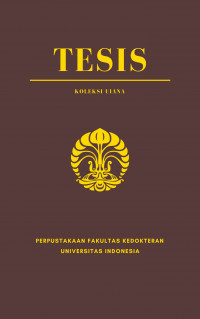Tesis
Perbandingan Gejala Klinis, Laboratorium dan Luaran Pasien COVID-19 Pada Anak Kondisi Imunokompromais dan Imunokompeten di Unit Rawat Jalan RS Rujukan Tersier = The Comparison of Clinical Symptoms, Laboratories and Outcomes between Immunocompromised and Imunocompetent Children with COVID-19 in Outpatient Clinic Tertiary Referral Hospital.
Latar belakang : Populasi anak umum kurang berisiko terhadap gejala berat infeksi COVID-19 dibanding populasi dewasa. Penelitian pada populasi anak dengan imunokompromais masih sedikit dan didapatkan adanya perbedaan data antara penelitian satu negara dengan negara lain. Tujuan : Menganalisis perbandingan karakteristik klinis, laboratorium dan luaran pasien anak dengan COVID-19 kondisi imunokompromais dan imunokompeten. Metode : Studi potong lintang dilakukan selama bulan Agustus – Desember 2020 di Poliklinik Demam RSCM Jakarta pada 273 anak terinfeksi COVID-19. Diagnosis ditegakkan berdasarkan pemeriksaan rRT – PCR SARS-CoV-2 dari spesimen usap nasofaring dan orofaring. Dilakukan juga pemeriksaan hematologi rutin, CRP, PCT, serologi SARS-CoV-2 kualitatif dan rontgen toraks. Hasil : Median usia kasus konfirmasi COVID-19 kondisi imunokompromais adalah 10,5 tahun (IQR 5,2–15), distribusi terbanyak pada usia >1 – 5 tahun dan jenis kelamin lelaki (60%). Prevalensi COVID-19 pasien imunokompromais dan imunokompeten berturut-turut adalah 20,8% dan 31,7%. Tidak didapatkan adanya riwayat kontak erat pada sebagian besar kasus konfirmasi COVID-19 kondisi imunokompromais dibanding imunokompeten. Namun kontak erat meningkatkan risiko COVID-19 (OR=3,18 IK95% 2,22-4,56; p= < 0,001). Tidak ada perbedaan pada gejala klinis kecuali pada gejala sesak nafas, didapatkan lebih tinggi pada pasien imunokompromais (OR=2,73, IK95% (1,82 – 4,08); p=0,001). Perbedaan pada parameter laboratorium adalah limfopenia, peningkatan ANC, NLR, eosinopenia, peningkatan PCT, CRP dan durasi shedding yang lebih lama (20,38 hari ± 5,37 vs 11 hari ± 2,54) pada pasien imunokompromais terutama yang mengonsumsi steroid (p=0,001). Perawatan di RS lebih tinggi pada imunokompromais dibanding imunokompeten (OR=4,18, IK95% 2,13 – 8,2; p=0,000) disebabkan karena progresivitas penyakit dasar. Terdapat 9,8% pasien yang menjalani perawatan di RS saat isolasi mandiri dengan rerata durasi sejak onset gejala adalah 7,42 ± 3,04 hari, dua pasien mendapat terapi hidroksikloroquin dan steroid untuk penyakit dasarnya dan semua pasien keluar RS dalam keadaan baik. Kesimpulan : Terdapat banyak perbedaan pada gejala klinis, laboratorium dan luaran pasien COVID-19 imunokompromais dibanding imunokompeten.
Kata kunci : Imunokompromais, COVID-19, anak
Background : Children are generally thought to be at less risk of severe symptoms of COVID-19 than adults. Evidence for the risk in children with immunocompromised condition is limited and there is disparities on data from developing and developed countries. Objective : To analyze the comparison of clinical characteristic, laboratories and outcomes in immunocompromised and immunocompetent childrens with COVID-19. Methods : A cross sectional study was conducted between August – December 2020 in outpatient clinic ‘Kiara’ RSCM Jakarta, 273 children with COVID-19 infection were enrolled. The diagnosis of COVID-19 was performed by rRT – PCR from naso/oropharingeal swab and followed by laboratory examination for hematological and serologic test for SARS-CoV-2 and chest x-ray examination. Results : Median age in confirmed COVID-19 case in immunocompromised children was 10.5 years (IQR 5.2 - 15), highest risk of infection in age group >1 – 5 years and male (60%). The prevalence of COVID-19 in immunocompromised and immunocompetent are respectively 20.8% and 31,7%. No evidence of closed contact history in most of the immunocompromised children, but risk of transmission of COVID-19 increase if history of close contacts is exist (OR=3,18 95%CI 2.22-4.56; p= < 0.001). There is no difference in clinical manifestation between two groups, but immunocompromised patients experienced markedly more dyspnea (OR=2.73 95%CI (1.82 – 4.08); p=0.001) than immunocompetent. Laboratory results showed lymphopenia, eosinophenia, elevated ANC, NLR, PCT, CRP and prolonged viral shedding in immunocompromised (20,38 days ± 5,37 vs 11 days ± 2,54) especially with steroid use. Hospitalization increase in immunocompromised (OR=4.18 95%CI 2.13 – 8.2; p=0.000) than immunocompetent because of progressive disease. During home isolation (mean 7,42 ± 3,04 hari), 9,8% patients require hospitalization because develop additional symptoms and symptoms get worse. Two patients with hydroxichloroquin and steroid medication for their chronic disease and discharge from hospital with good condition. Summary : There were many differences between patients with immunocompromised and immunocompetent diagnosed with COVID-19 in their clinical, laboratory and outcomes.
Keywords : Immunocompromised, COVID-19, children
- Judul Seri
-
-
- Tahun Terbit
-
2021
- Pengarang
-
Irma Rezky Ratu, T - Nama Orang
Nina Dwi Putri - Nama Orang
MURTI ANDRIASTUTI - Nama Orang - No. Panggil
-
T21185fk
- Penerbit
- Jakarta : Sp-2 Ilmu Kesehatan Anak., 2021
- Deskripsi Fisik
-
xvi, 65 hlm. ; 21 x 30 cm
- Bahasa
-
Indonesia
- ISBN/ISSN
-
-
- Klasifikasi
-
NONE
- Edisi
-
-
- Subjek
- Info Detail Spesifik
-
Tanpa Hardcopy
| T21185fk | T21185fk | Perpustakaan FKUI | Tersedia |


Masuk ke area anggota untuk memberikan review tentang koleksi